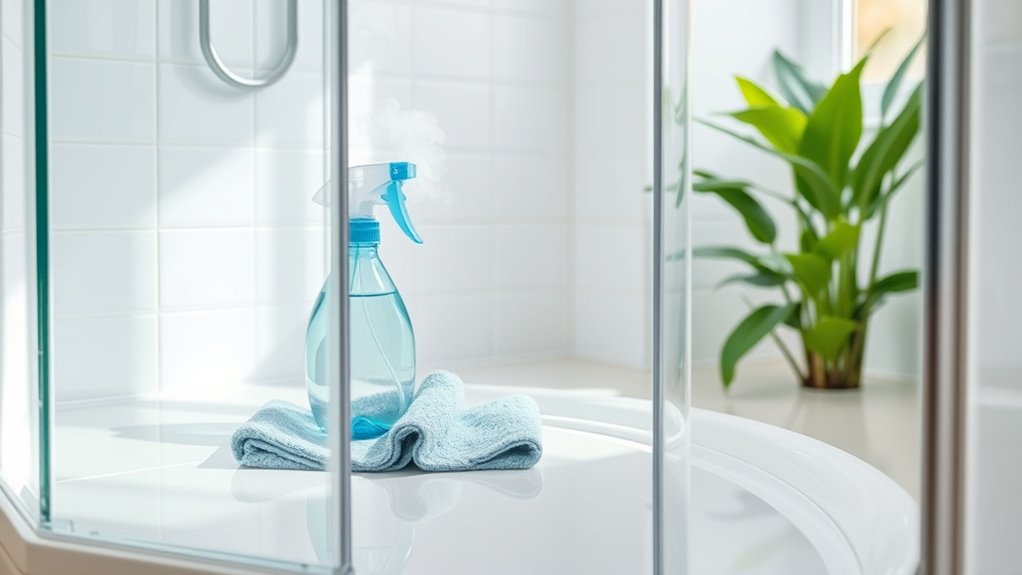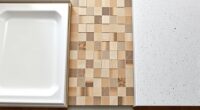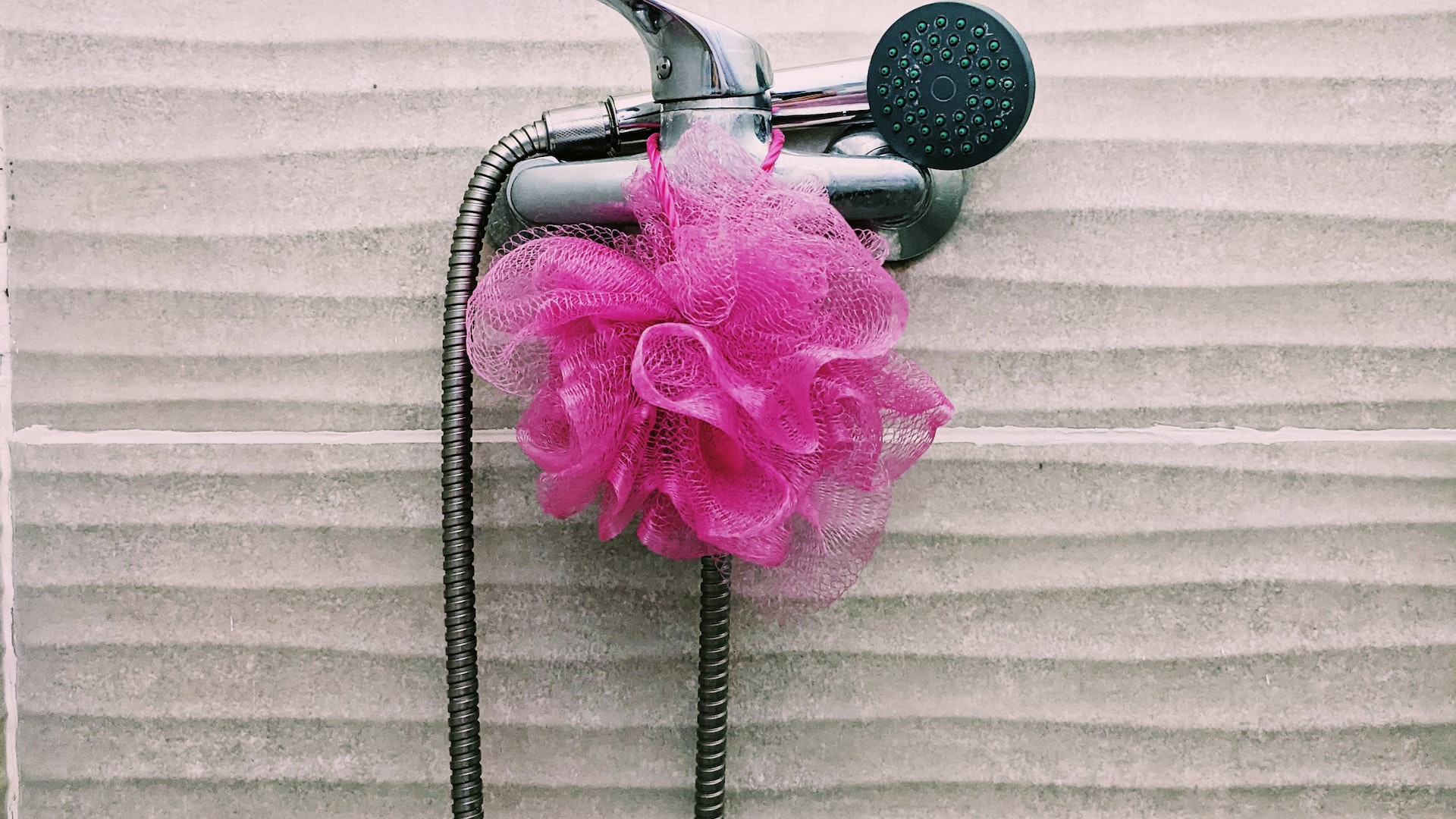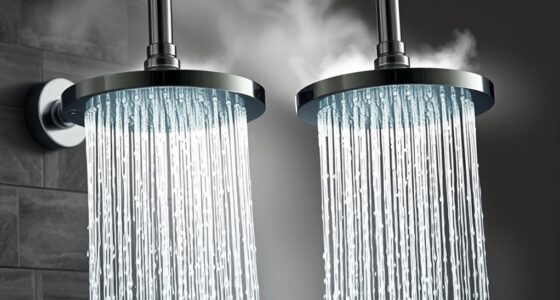To prevent shower mold and mildew, keep your bathroom well-ventilated by running exhaust fans during and after showers, and open windows if possible. Wipe down shower walls and glass doors after each use with a squeegee or cloth to remove excess moisture. Regularly clean grout lines and surfaces with vinegar-based solutions or mold-proof paint to inhibit mold growth. Maintaining moisture control and consistent cleaning will help keep your bathroom mold-free—learn more to protect your space.
Key Takeaways
- Use exhaust fans during and after showers to remove excess moisture and reduce mold growth.
- Wipe down shower surfaces daily with a squeegee or cloth to eliminate water droplets.
- Apply mold-resistant paint on walls and ceilings to inhibit mold development over time.
- Regularly clean grout lines, corners, and behind fixtures with vinegar or mold cleaner.
- Maintain good ventilation, fix leaks promptly, and keep the bathroom dry to prevent mold and mildew buildup.

Mold and mildew thrive in damp, poorly ventilated showers, making prevention vital for maintaining a healthy bathroom environment. When moisture lingers after your shower, it creates the perfect conditions for mold spores to settle and grow. To combat this, focus on ventilation improvements that can notably reduce humidity levels. Installing an exhaust fan or upgrading your existing one ensures moist air is quickly removed from the space. Keep the fan on during and after showers for at least 15-20 minutes to dry out the area thoroughly. Additionally, opening a window or using a dehumidifier can further help reduce lingering moisture, especially in bathrooms without dedicated ventilation systems.
Another effective strategy involves choosing mold resistant paint for your bathroom walls and ceilings. This special paint contains antimicrobial properties that inhibit mold and mildew growth, making it a smart long-term investment. When applying mold resistant paint, make sure the surface is clean, dry, and free of existing mold or mildew. This creates a barrier that’s much harder for mold spores to penetrate, even in high-humidity environments. Pairing mold resistant paint with ongoing maintenance routines greatly lowers the chances of mold developing over time.
Beyond improving ventilation and applying mold resistant paint, regular cleaning plays a vital role in prevention. Wipe down shower walls and glass doors after each use to remove excess moisture that could encourage mold growth. Use a squeegee or soft cloth to eliminate water droplets from tiles, glass, and grout lines. Pay special attention to grout, as it tends to trap moisture. Regularly cleaning with a mixture of vinegar and water or a commercial mold cleaner can help keep mold spores at bay. Be sure to focus on corners, crevices, and behind fixtures where water tends to collect unnoticed. Incorporating automated cleaning tools can further streamline maintenance efforts.
Maintaining dry conditions is key, so consider running the bathroom exhaust fan during your shower and for at least 15 minutes afterward. Keep your bathroom well-ventilated even when not in use by leaving the door or window open if possible. Fix leaks promptly, as any persistent water intrusion can create ideal mold-friendly environments. Dry any wet towels or bath mats outside the bathroom, and store them in a well-ventilated area to prevent excess moisture buildup.
Frequently Asked Questions
What Are the Best Natural Remedies to Prevent Shower Mold?
To prevent shower mold naturally, you can use essential oils like tea tree or eucalyptus, which have antifungal properties. Mix a few drops with water and spray in your shower. Baking soda also helps by absorbing moisture and odors; sprinkle it lightly on surfaces and scrub gently. Regular cleaning with these remedies keeps your shower dry and inhospitable for mold growth, making your bathroom safer and fresher.
How Often Should I Replace Shower Curtains to Avoid Mold?
Did you know that most shower curtains last about 1-2 years? To avoid mold, you should replace your shower curtain regularly, especially if you notice signs of mold or mildew. Opt for mold-resistant fabrics or materials with a longer shower curtain lifespan. Cleaning your curtain weekly and ensuring proper ventilation can extend its life, but replacing it every year keeps your bathroom fresh and mold-free.
Can a Humidifier Help Reduce Mold Growth in Bathrooms?
A humidifier can help with bathroom humidity control, but its effectiveness in reducing mold growth depends on proper use. By maintaining lower humidity levels, you create an environment less conducive to mold. Make certain your humidifier isn’t adding excess moisture, which can worsen the problem. Use it alongside good ventilation and regular cleaning to effectively manage bathroom humidity and minimize mold risk.
Are There Specific Shower Materials That Resist Mold Better?
Think of your shower as a fortress against mold. Stainless steel and ceramic tile are like sturdy walls, resisting mold better than porous materials. Stainless steel’s sleek surface doesn’t invite spores, while ceramic tile’s glazed finish keeps moisture at bay. Choosing these materials means your shower becomes a resilient sanctuary, making mold less likely to take hold. With proper care, your shower stays fresh, reflecting your effort to keep mold out.
How Does Water Temperature Influence Mold Development in Showers?
Water temperature plays a significant role in mold growth in your shower. Hot water encourages mold development because it creates a warm, moist environment perfect for mold spores to thrive. Lowering the water temperature can slow down mold growth, but make sure it’s still comfortable for your shower. By controlling water temperature, you reduce the ideal conditions for mold to develop, helping keep your shower cleaner and mold-free longer.
Conclusion
By following these cleaning and maintenance tips, you’re like a vigilant gardener tending to your shower’s health. I once neglected mine for a week, and mold quickly took root—reminding me how easily mold can grow when we’re not paying attention. Keep your shower dry and clean, and you’ll protect your space from unwanted invaders. Think of your bathroom as a sanctuary—you’re the gardener, and mold is the weed you refuse to let thrive.










